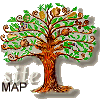| TYPE AND ORDER OF DRAWINGS
 The following is a checklist of the usual drawings and their contents for a typical project. They are listed in the order most often used in assembled sets of drawings. Those marked with an asterisk (*) would not be on separate sheets where the total number of sheets is small (10 to 15 sheets). In that case, the information would be incorporated on the remaining drawings. The checklist is as follows: The following is a checklist of the usual drawings and their contents for a typical project. They are listed in the order most often used in assembled sets of drawings. Those marked with an asterisk (*) would not be on separate sheets where the total number of sheets is small (10 to 15 sheets). In that case, the information would be incorporated on the remaining drawings. The checklist is as follows:
- Cover Sheet*: this drawing usually shows a perspective view of the building. It also displays the title information in bold face.
- Index*: the index gives a drawing list and tabular columns for revision numbers, remarks, parties issued to, etc. A legend for symbols indicating materials (brick, stone, wood, etc.), survey stations, photo key notations, section notations, etc., may be indicated on this sheet.
- Site Plan: the site plan shows the legal boundaries; the topographical features, including contours, vegetation, trees, roads, walks, fences and other man-made features; and the buildings. If the grid system is employed, the baseline of the grid, including its true bearing and tie-in dimensions to permanent features, is indicated as well as the level reference datum. Included with the site plan is the location plan, which is a map enabling one to find the property with reference to main roads, towns or natural features.
- Floor Plans: the main floor and upper floor plans (if any) are always included. In addition, depending upon the scope of the survey, plans at the following levels may be required: foundation plan, reflected ceiling plans (crawl space, main and upper floors), attic joist plan, rafter plan and roof plan.
- Elevations: exterior and interior elevations some interior elevations will be shown on the cross-sections.
- Sections: these are used to show construction and interior elevations. They should be chosen carefully to illustrate the most significant typical situations. Often the stairs can be included in one of the sections. A simple building may require only one section.
- Details*: these may be split into two categories - structural and architectural. Structural details are best illustrated by sectional, isometric or exploded views,
|
 |
accompanied with complete notes. Larger scale sections and details, of joints are often required. Architectural detail includes stairways, doorways, doors and windows, mantels, panelling, moldings and hardware. These are most often shown in larger scale elevations and sections. The construction of such detail, including materials, should be recorded wherever possible. For hardware, a magnet is useful to determine ferrous material.
- Photo Key Plans: these may be produced from duplicate negatives of relevant drafted floor plans or from free-hand sketches on which camera position, tilt and photo reference numbers are indicated. See section on Photographs.
SEQUENCE OF OPERATIONS FOR COMPLETING THE DRAWINGS
 The following steps are given as a guide: The following steps are given as a guide:
- Resolution of Plans, Elevations and Sections: as described previously in this section, these views are plotted prior to the completion of field work and any discrepancies are resolved.
- Layout: the plans, elevations and sections are traced onto the final sheets, observing guidelines on arrangement and order of views. No dimensions or notes are shown at this stage. Details previously plotted on small pieces of paper are positioned under the final sheets and traced.
- Ink: where applicable, all drawings are inked.
- Print: reproduceable prints (see Drawing Media Standards, following) are taken of the plans, elevations and sections. These negatives, commonly called "barebacks," are stored for future use. Ordinary blue prints are taken of all drawings for mark-up.
- Mark-up: blue prints are used for planning dimension lines and dimensioning, annotations, titling and cross-referencing. Once finalized in pencil on the blue prints, the information is drafted onto the final drawings in ink or pencil, as the case may be.
- Photo Key Plans: the photo notations and reference numbers are often drafted on "bareback" prints of the appropriate plans.
- Final Check: blue prints are taken of the entire set of annotated and dimensioned drawings for final checking and correction.
|








